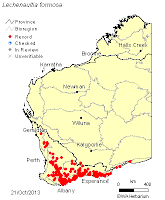L. biloba is the better known member of the species and is commonly cultivated in many areas of Australia. It grows in woodland and shrubland, usually on sand or gravel in the Darling Range east of Perth, Western Australia and east to Lake King. It is usually about 300mm (12 ins) or less in height by a similar width.
It is a very popular and spectacular small shrub with intense blue flowers (in its common form). In suitable climates it is an ideal rockery plant and tolerates exposed, hot, sunny positions despite its delicate appearance. It is fairly short lived (4-6 years) in ideal conditions but is easily propagated from cuttings. As it is a native of south Western Australia it prefers climates with dry summers.

Lechenaultia formosa is very widespread in southern Western Australia from the coast to the mallee regions, growing in non-calcareous sand or gravel soils. It is however a moisture loving plant and generally occurs in low-lying or ephemeral seepage zones that may flood after heavy rain and slowly drain rather than evaporate.
Although the beautiful L. biloba comes in both deep and pale blue L. formosa is the most outstanding species with the greatest spectrum of colours which range from yellow to scarlet and every hue in between. They are not flat colours but like deep velvet and as you peer into them the colours become richer or shift to other tints.
Depending on the timing of seasonal rainfall, flowering can occur between May and November, but when conditions are suitable, plants will produce considerable numbers of flowers the size of your thumbnail over several months. I am sorry to show so many (well no I'm not really sorry) pictures of this lechenaultia but they are so lovely I just couldn't resist.
Lechenaultia floribunda is also native to Western Australia:
It is a diffuse, ascending shrub 0.15-1 metre high with blue/white flowers from August to December and grows on white/grey or yellow sand. Perhaps not quite as spectacular as the first two (above) but still very beautiful:

Leptoceras menziesii is native to Western Australia. It is a tuberous perennnial orchid 0.1-0.3m high with white, pink and red flowers from September to November. Each of these has forward-facing white lateral sepals, and a pink and white hood-shaped central structure. The petals, often deep red, are relatively long and erect, their appearance inspiring the common name of Rabbit Orchid. It grows on sand, peaty or granitic loam and clay in winter-wet areas, granite outcrops and creek margins.
Does this last picture remind me of someone you may have known perhaps? An old chap with a cap and a beard maybe or is my imagination running riot!!




















Hari OM
ReplyDelete...well it's nearly there so it could be him in disguise!! What fun and these are absolute stunners. The blue bilbosa I recognise from mum's garden in Mandurah. YAM xx
haha Yes the blue lechenaultia is very popular with home gardeners. These certainly are fantastic flowers. Thanks Yam. x
DeleteLove the blues.
ReplyDeleteSo do I but the red and its variations are quite stunning too.
DeleteL is for lucious and lovely. And all of these stunners fill me with lust. Thank you.
ReplyDeleteWhat's that old song? It's delightful..it's d'lovely? I think those adjectives rightfully belong to all these flowers. You could surely grow some of them perhaps? Glad you enjoyed them.
DeleteOrchids certainly have some wonderfully varied shapes, I love the two you have pictured here.
ReplyDeleteOur orchids really are outstanding aren't they. Not all of them of great beauty but its their diversity I find so intriguing. I'd not even heard of these two previously so I'm leaning so much about our native flora.
DeleteMy name is William Archer from the Blog 'Esperance Wildflowers' and note you are using a number of my photographs, plus text in your blog 'A geriatric grandmother.' You have not been given permission to use them and request they be removed from your blog immediately and refrain from using our property in future. Failure to do so will result in legal action.
ReplyDelete